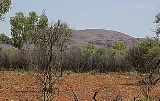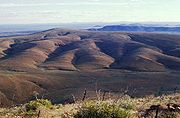
Central Mount Stuart
Encyclopedia
Central Mount Stuart is a mountain
peak situated in the southern Northern Territory
, Australia
. It is a prominent landmark easily seen from the nearby Stuart Highway
, which at closest approach lies about 6 km to the southeast. The dark red sandstone
that comprise the peak, referred to by geologists as Central Mount Stuart Formation, form part of the Georgina Basin
.
The mountain is named in honour of explorer John McDouall Stuart
. Stuart reached the area on 22 April 1860 and determined a point approximately 4 km (2.5 mi) south-southwest of the peak to be the centre of Australia (this assessment is not supported by modern geographers). He climbed to the top the next day, writing in his journal:
 Stuart originally named the peak Central Mount Sturt, after his former expedition leader Charles Sturt
Stuart originally named the peak Central Mount Sturt, after his former expedition leader Charles Sturt
. The name was changed (possibly at the instigation of James Chambers) soon after Stuart's return at Adelaide
at the end of the expedition, such that Central Mount Stuart is the name that appeared in the published expedition journal.
Mountain
Image:Himalaya_annotated.jpg|thumb|right|The Himalayan mountain range with Mount Everestrect 58 14 160 49 Chomo Lonzorect 200 28 335 52 Makalurect 378 24 566 45 Mount Everestrect 188 581 920 656 Tibetan Plateaurect 250 406 340 427 Rong River...
peak situated in the southern Northern Territory
Northern Territory
The Northern Territory is a federal territory of Australia, occupying much of the centre of the mainland continent, as well as the central northern regions...
, Australia
Australia
Australia , officially the Commonwealth of Australia, is a country in the Southern Hemisphere comprising the mainland of the Australian continent, the island of Tasmania, and numerous smaller islands in the Indian and Pacific Oceans. It is the world's sixth-largest country by total area...
. It is a prominent landmark easily seen from the nearby Stuart Highway
Stuart Highway
The Stuart Highway is one of Australia's major highways. It is a segment of Australia's Highway 1 extending from Darwin, Northern Territory, in the north, via Tennant Creek and Alice Springs, to Port Augusta, South Australia, in the south—a distance of...
, which at closest approach lies about 6 km to the southeast. The dark red sandstone
Sandstone
Sandstone is a sedimentary rock composed mainly of sand-sized minerals or rock grains.Most sandstone is composed of quartz and/or feldspar because these are the most common minerals in the Earth's crust. Like sand, sandstone may be any colour, but the most common colours are tan, brown, yellow,...
that comprise the peak, referred to by geologists as Central Mount Stuart Formation, form part of the Georgina Basin
Georgina Basin
The Georgina Basin is a large intracratonic sedimentary basin in central and northern Australia, lying mostly within the Northern Territory and partly within Queensland. It is named after the Georgina River which drains part of the basin. Deposition of locally up to ca...
.
The mountain is named in honour of explorer John McDouall Stuart
John McDouall Stuart
John McDouall Stuart was one of the most accomplished and famous of all Australia's inland explorers. Stuart led the first successful expedition to traverse the Australian mainland from south to north and return, and the first to do so from a starting point in South Australia, achieving this...
. Stuart reached the area on 22 April 1860 and determined a point approximately 4 km (2.5 mi) south-southwest of the peak to be the centre of Australia (this assessment is not supported by modern geographers). He climbed to the top the next day, writing in his journal:
"Took Kekwick and the flag, and went to the top of the mount, but found it to be much higher and more difficult of ascent than I anticipated. After a deal of labour, slips, and knocks, we at last arrived on the top. It is quite as high as Mount Serle, if not higher. The view to the north is over a large plain of gums, mulga, and spinifex, with watercourses running through it. The large gum creek that we crossed winds round this hill in a north-east direction; at about ten miles it is joined by another. After joining they take a course more north, and I lost sight of them in the far-distant plain. To the north-north-east is the termination of the hills; to the north-east, east and south-east are broken ranges, and to the north-north-west the ranges on the west side of the plain terminate. To the north-west are broken ranges; and to the west is a very high peak, between which and this place to the south-west are a number of isolated hills. Built a large cone of stones, in the centre of which I placed a pole with the British flag nailed to it. Near the top of the cone I placed a small bottle, in which there is a slip of paper, with our signatures to it, stating by whom it was raised. We then gave three hearty cheers for the flag, the emblem of civil and religious liberty, and may it be a sign to the natives that the dawn of liberty, civilization, and Christianity is about to break upon them. We can see no water from the top. Descended, but did not reach the camp till after dark."

Charles Sturt
Captain Charles Napier Sturt was an English explorer of Australia, and part of the European Exploration of Australia. He led several expeditions into the interior of the continent, starting from both Sydney and later from Adelaide. His expeditions traced several of the westward-flowing rivers,...
. The name was changed (possibly at the instigation of James Chambers) soon after Stuart's return at Adelaide
Adelaide
Adelaide is the capital city of South Australia and the fifth-largest city in Australia. Adelaide has an estimated population of more than 1.2 million...
at the end of the expedition, such that Central Mount Stuart is the name that appeared in the published expedition journal.

